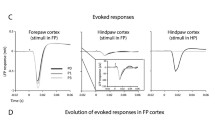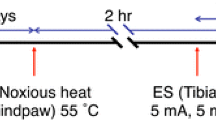Summary
The aim of this study was to determine the discharge and receptive field properties of spinal cord neurons with ankle input in spinal segments L4-6 in the rat, both under control conditions and during the course of an adjuvant-induced unilateral inflammation in the ankle. The extent of receptive fields in the skin and deep tissue was assessed using brush, pinch and compression stimuli. Neurons were categorized as nociceptive-specific or wide-dynamic-range neurons on the basis of their response thresholds and responses to suprathreshold stimuli. At all stages of inflammation (2, 6, 13 and 20 days post inoculation) the population of neurons with ankle input showed differences from the population of neurons with ankle input in control rats. There was a reduction in the number of neurons that appeared as nociceptive specific and a concomitant increase in the number of neurons showing a wide-dynamic-range response profile. The receptive fields of the neurons with ankle input were markedly larger in rats with inflammation in the ankle region and mainly spread proximally on the ipsilateral hindlimb and also to the abdomen and tail in some cases. There was also an increase in the number of neurons with contralateral excitatory inputs. The mechanical thresholds at the ankle joint and proximal parts of the ipsilateral hindlimb were less in arthritic rats than in controls. The proportion of spontaneously active neurons was also increased in rats during the initial and later stages of inflammation, although there was no significant increase in the mean spontaneous discharge frequency. These data show that there are long-term changes in the receptive field and response properties of neurons in intact rats with chronic unilateral adjuvant-induced inflammation similar to those described previously in spinal cats with acute inflammation (Neugebauer and Schaible 1990). It is presumed that similar afferent and spinal mechanisms are at work under acute and chronic inflammatory conditions which produce hyperexcitability in spinal neurons with joint input.
Similar content being viewed by others
References
Besson JM, Chaouch A (1987) Peripheral and spinal mechanisms of nociception. Physiol Rev 67:67–186
Billingham MEJ, Davies GE (1979) Experimental models of arthritis in animals as screening tests for drugs to treat arthritis in man. In: Born GVR, Rensselaer AF, Herkin H, Welch AD (eds) Handbook of experimental pharmacology, vol 50/II. Springer, Berlin Heidelberg New York pp 108–144
Birrell GJ, McQueen DS, Iggo A, Grubb BD (1990) The effects of 5-HT on articular sensory receptors in normal and arthritic rats. Br J Pharmacol 101:715–721
Calvino B, Villanueva L, LeBars D (1987a) Dorsal horn (convergent) neurones in the intact anaesthetised arthritic rat. I. Segmental excitatory influences. Pain 28:81–98
Calvino B, Villanueva L, LeBars D (1987b) Dorsal horn (convergent) neurones in the intact anaesthetized arthritic rat. II. Heterotopic inhibitory influences. Pain 31:359–379
Campbell RC (1989) Statistics for biologists, 3rd edn. Cambridge University Press, Cambridge
Cervero F, Wolstencroft JH (1984) A positive feedback loop between spinal cord nociceptive pathways and antinociceptive areas of the cat's brain stem. Pain 20:125–138
Cervero F, Schaible H-G, Schmidt RF (1991) Tonic descending inhibition of spinal cord neurones driven by joint afferents in normal cats and in cats with an inflamed knee. Exp Brain Res 83:675–678
Coghill RC, Price DD, Hayes RL, Mayer DJ (1991) Spatial distribution of nociceptive processing in the rat spinal cord. J Neurophysiol 65:133–140
Colpaert FC (1987) Evidence that adjuvant arthritis in the rat is associated with chronic pain. Pain 28:201–222
Cook AJ, Woolf CJ, Wall PD, McMahon SB (1987) Dynamic receptive field plasticity in rat spinal cord dorsal horn following C-primary afferent input. Nature 325:151–153
Craig AD, Kniffki KD (1985) Spinothalamic lumbosacral lamina I cells responsive to skin and muscle stimulation in the cat. J Physiol (Lond) 365:197–221
Dorn T, Schaible H-G, Schmidt RF (1991) Response properties of thick myelinated group II afferents in the medial articular nerve of normal and inflamed knee joints of the cat. Somatosens Mot Res 8:127–136
Duggan AW, Weihe E (1991) Central transmission of impulses in nociceptors: events in the superficial dorsal horn. In: Basbaum AI, Besson J-M (eds) Towards a new pharmacotherapy of pain. Wiley, New York, pp 35–67
Fields HL, Clanton CH, Anderson SD (1977) Somatosensory properties of spinoreticular neurons in the cat. Brain Res 120:49–66
Gogas KR, Presley RW, Levine JD, Basbaum AI (1991) The antinociceptive action of supraspinal opioids results from an increase in decending inhibitory control: correlation of nociceptive behavior and c-fos expression. Neuroscience 42:617–628
Grigg P, Schaible H-G, Schmidt RF (1986) Mechanical sensitivity of group III and IV afferents from posterior articular nerve in normal and inflamed cat knee. J Neurophysiol 55:635–643
Grubb BD, Schaible H-G (1991a) Response properties of spinal cord neurones with ankle joint input in the normal rat. Pflugers Arch [Suppl] 418:R20
Grubb BD, Schaible H-G (1991b) Dynamic changes in the response properties of rat spinal cord neurons with ankle joint input during chronic monoarthritis. Pflugers Arch [Suppl] 418:R19
Grubb BD, McQueen DS, Iggo A, Birrell GJ, Dutia MB (1988) A study of 5-HT-receptors associated with afferent nerves located in normal and inflamed rat ankle joints. Agents Actions 25:216–218
Grubb BD, Birrell GJ, McQueen DS, Iggo A (1991) The role of PGE2 in the sensitization of mechanoreceptors in normal and inflamed ankle joints of the rat. Exp Brain Res 84:383–392
Guilbaud G (1988) Peripheral and central electrophysiological mechanisms of joint and muscle pain. In: Dubner R, Gebhart GF, Bond MR (eds) Proceedings of the Vth World Congress on Pain, Elsevier, Amsterdam, pp 201–215
Guilbaud G, Iggo A, Tegner R (1985) Sensory receptors in ankle joint capsules of normal and arthritic rats. Exp Brain Res 58:29–40
Guilbaud G, Kayser V, Benoist JR, Gautron M (1986) Modifications in the responsiveness of rat ventrobasal thalamic neurons at different stages of carrageenan-proudced inflammation. Brain Res 385:86–98
Hoheisel U, Mense S (1989) Spinal projections of thin myelinated deep afferents and their topical relation to dorsal horn neurones processing deep input. In: Cervero F, Bennett GJ, Headley PM (eds) Processing of sensory information in the superficial dorsal horn of the spinal cord. (NATO ASI series) Plenum Press, New York, pp 29–40
Hylden JLK, Nahin RL, Anton F, Dubner R (1989a) Characterization of lamina I projection neurons: physiology and anatomy. In: Cervero F, Bennett GJ, Headley PM (eds) Processing of sensory information in the superficial dorsal horn of the spinal cord. (NATO ASI series) Plenum Press, New York, pp 113–128
Hylden JLK, Nahin RL, Traub RJ, Dubner R (1989b) Expansion of receptive fields of spinal lamina I projection neurons in rats with unilateral adjuvant-induced inflammation: the contribution of dorsal horn mechanisms. Pain 37:229–243
Iadarola MJ, Douglass J, Civelli O, Naranjo JR (1988a) Differential activation of spinal cord dynorphin and enkephalin neurons during hyperalgesia: evidence using cDNA hybridization. Brain Res 455:205–212
Iadarola MJ, Ruda MA, Cohen LV, Flores CM, Naranjo JR (1988b) Enhanced dynorphin gene expression in spinal cord dorsal horn neurons during peripheral inflammation: behavioral, neuropeptide, immunocytochemical and mRNA studies. In: Dubner R, Gebhart GF, Bond MR (eds) Proceedings of the Vth World Congress on Pain. Elsevier, Amsterdam, pp 61–71
Jones RS, Ward JR (1966) Adjuvant-induced polyarthritis in rats. In: Bajusz E, Jasmin G (eds) Methods and achievements in experimental pathology, vol 1. Karger, Basel New York, pp 607–638
McMahon SB, Wall PD (1989) The significance of plastic changes in lamina I systems. In: Cervero F, Bennett GJ, Headley PM (eds) Processing of sensory information in the superficial dorsal horn of the spinal cord. (NATO ASI Series) Plenum Press, New York, pp 249–271
Menétrey D, Besson J-M (1982) Electrophysiological characteristics of dorsal horn cells in rats with cutaneous inflammation resulting from chronic arthritis. Pain 13:243–364
Millan MJ, Czlongkowski A, Pilcher CWT, Almeida OFX, Millan MH, Colpaert FC, Herz A (1987) A model of chronic pain in the rat: functional correlates of alterations in the activity of opioid systems. J Neurosci 7:77–87
Neugebauer V, Schaible H-G (1990) Evidence for a central component in the sensitization of spinal neurons with joint input during development of acute arthritis in cat's knee. J Neurophysiol 64:299–311
Pearson CM (1963) Experimental joint disease. Observations on adjuvant-induced arthritis. J Chron Dis 16:863–874
Perl ER (1984) Pain and nociception. In: Handbook of physiology. The nervous system. Sensory Processes, sect 1, vol III, part II. American Physiological Society, Bethesda, pp 915–975
Presley RW, Menetrey D, Levine JD, Basbaum AI (1990) Systemic morphine suppresses noxious stimulus-evoked fos protein-like immunoreactivity in the rat spinal cord. J Neurosci 10:323–335
Schaible H-G, Schmidt RF (1985) Effects of an experimental arthritis on the sensory properties of fine articular afferent units. J Neurophysiol 54:1109–1122
Schaible H-G, Schmidt RF (1988) The time course of mechanosensitivity changes in articular afferents during a developing experimental arthritis. J Neurophysiol 60:2180–2195
Schaible H-G, Schmidt RF, Willis WD (1986) Responses of spinal cord neurones to stimulation of articular afferent fibres in the cat. J Physiol (Lond) 372:575–593
Schaible H-G, Schmidt RF, Willis WD (1987a) Convergent inputs from articular, cutaneous and muscle receptors onto ascending tract cells in the cat spinal cord. Exp Brain Res 66:479–488
Schaible H-G, Schmidt RF, Willis WD (1987b) Enhancement of the responses of ascending tract cells in the cat spinal cord by acute inflammation of the knee joint. Exp Brain Res 66:489–499
Schaible H-G, Neugebauer V, Cervero F, Schmidt RF (1991) Changes in tonic descending inhibition of spinal neurons with articular input during the development of acute arthritis in the cat. J Neurophysiol 66:1021–1032
Simone DA, Sorkin LS, Oh U, Chung JM, Owens C, LaMotte RH, Willis WD (1991) Neurogenic hyperalgesia: central neural correlates in responses of spinothalamic tract neurons. J Neurophysiol 66:228–246
Weihe E, Millan MJ, Hoellt V, Nohr D, Herz A (1989) Induction of the gene encoding prodynorphin by experimentally induced arthritis enhances staining for dynorphin in the spinal cord of rats. Neuroscience 31:77–95
Willis WD (1985) The pain system. The neural basis of nociceptive transmission in the mammalian nervous system. Karger, Basel, New York
Woolf CJ (1983) Evidence for a central component of post-injury pain hypersensitivity. Nature 306:686–688
Yu X-M, Mense S (1990a) Response properties and descending control of rat dorsal horn neurons with deep receptive fields. Neuroscience 39:823–831
Yu X-M, Mense S (1990b) Somatotopical arrangement of rat spinal dorsal horn cells processing input from deep tissues. Neurosci Lett 108:43–47
Author information
Authors and Affiliations
Rights and permissions
About this article
Cite this article
Grubb, B.D., Stiller, R.U. & Schaible, H.G. Dynamic changes in the receptive field properties of spinal cord neurons with ankle input in rats with chronic unilateral inflammation in the ankle region. Exp Brain Res 92, 441–452 (1993). https://doi.org/10.1007/BF00229032
Received:
Accepted:
Issue Date:
DOI: https://doi.org/10.1007/BF00229032




